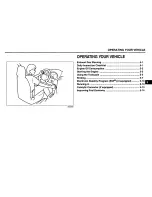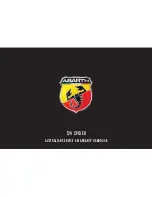
45
Engine cylinder head
At operation of the engine it is not required to tighten up the cylinder head bolts. If necessary, tighten only on a cold
engine. To ensure a uniform and tight fit of the cylinder head to the gasket, tighten the bolts in the sequence shown in Fig.
9.1a in two steps (with a metal cylinder-head gasket) and Fig. 9.1b (with a cylinder-head gasket made of asbostal sheet).
Tighten the bolts evenly using a torque wrench (see Annex 2).
In the event of higher oil burn rate, knock and glow ignition, remove the cylinder head and clean the surface of the
combustion chambers, valve collars and pistons crowns from the burnt deposit.
F
ron
t
F
ron
t
Fig. 9.1 Sequence of tightening of bolts for fastening of cylinder block head:
a - with a metal cylinder-head gasket;
b - with cylinder-head gasket of asbostal sheet
Engine valve train
The drive of camshafts - chain, two-stage. The tension of the chains is carried out by hydraulic tensioners.
CAUTION! It is not allowed to remove the hydraulic tensioner from the chain cover in order to prevent the plunger
from disengaging from the housing under the action of a compressed spring, after which it will be necessary to assemble
it in a special fixture.
The valves are driven from the camshafts directly through cylindrical hydraulic pushers. The use of hydraulic
pushers eliminates the need to adjust the clearances.
Engine lubrication system
In the event of lubrication system fault, engine operation shall be immediately terminated.
An oil cooler is provided to cool down the oil in the lubrication system which is automatically included in the
cooling process by means of a thermal valve.
Regularly check the oil level in the engine crankcase and, if necessary, refill it. Check before starting the engine. In
the case of checking the oil level after engine stop, you must wait at least 15 minutes for the oil to flow into the crankcase.
The vehicle shall be on a flat
, horizontal site. The oil level shall be between the “0” and “F” marks of oil level indicator 9
(Fig. 9.2). When frequent trips over rough terrain, maintain the oil level near the F mark, not exceeding it. The amount of
oil required to top up the engine f
rom the “0” mark to the “F” mark is 1 liter.
Fig. 9.2 Engine (left view):
1 - pipe supply of coolant from the radiator to the water pump; 2 - connecting hoses; 3 - thermostat housing; 4 - coolant temperature
sensor of control system; 5 - coolant pipe from the thermostat to the radiator; 6+ - oil emergency pressure alarm sensor; 7 - crankshaft
position sensor connector; 8 - ignition coils; 9 - oil level indicator; 10 - rear engine lift bracket; 11 - exhaust manifold screen; 12 -
exhaust manifold; 13 - flywheel; 14 - clutch; 15 - clutch case reinforcer; 16 - crankcase; 17 - oil drain plug.
















































